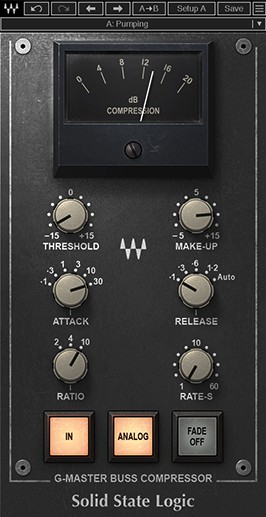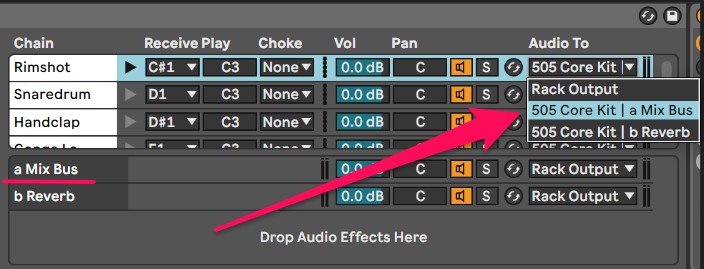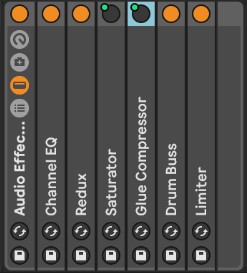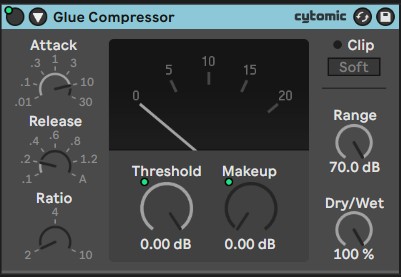
Have you ever thought that your drums seem to lack impact? Do they feel weak and flat in comparison to your favourite tracks? You may be missing this one simple step in drum production that could give your beats the chest-wobbling punch they crave:
'Glue' Compression!
But what exactly is 'glue' compression, and how do we apply it in our own drum production?

In short, this process simply involves adding a compressor to your drum group/bus, and applying light compression settings that ultimately give the drums a tight and punchy feel.
This effect of the compression also gives a certain cohesiveness to the drum sounds, hence the use of the term 'glue'.
Compressors can serve a variety of purposes - to tame peaks in level, control dynamic range and shape sounds - but they are also very useful in glueing a mix together to give a tight, polished feel.
Whatever compressor you have at your disposal, you can try out for this purpose. However, there are some compressors that are designed with this glueing goal in mind - the Waves SSL G-Master Buss Compressor is modelled on the SSL 4000 G console, and is one that many swear by.

The Glue Compressor from Cytomic (available in Ableton Live) is modelled on the classic '80s British big console buss compressor, and is one that we'll take a quick look at now.
If you're an Ableton user, drag one of the stock Drum Racks onto a new MIDI channel. You can also use one from our Hits & Patches packs that all include Ableton Drum Racks:


If we click the small icons on the left to reveal the output section and return chain, we can see that each drum is being routed to a chain called 'Mix Bus'. Clicking on 'Mix Bus' then reveals an Audio Effect Rack which shows all the different FX that are being applied to the drums as a unit:

This is one of the reasons that Ableton's stock kits often sound better than your own ;) - but that changes today!
As you can see above, there are several plugins being applied to the Drum Rack, but the one we're interested in for the purposes of this article is the Glue Compressor. Let's open up the effect to see what's there:

Here we can see the typical settings that you'd expect to use when trying to glue sounds together - slow attack, fast release and low ratio. Of course, there are no hard and fast rules on exact numbers to choose here, and settings will sound slightly different from plugin to plugin.
The point is we are trying to apply light compression that will draw the sounds together in a subtle way, while retaining the punch of the sample transients.
From here, the Threshold would then be adjusted during playback to determine when the compression kicks in - the level of compression is visualised on the meter, with more severe compression registering a higher number.
Since we're aiming for a light touch, somewhere between 1 - 4 dB (of gain reduction) on the meter would probably sound best. Again, don't rely on the numbers and visuals to tell you what's right - use your ears!

So, with all that, let's lay out the main steps to upping your drum game with some compression:
1. Route all your drum parts to a stereo drum bus/group (if they aren't already)2. Add your compressor of choice to the FX chain
3. Set 'attack' to slow (high number)
4. Set 'release' to fast (low number)
5. Set 'ratio' to a low - medium setting (2 - 4)
6. Hit 'Play' in your DAW session so you can hear the drums play back
7. Adjust 'threshold' until you start to see a few dB of gain reduction (and hear it, more importantly!)
8. Now play around with the settings, and notice how they affect the overall sound. You're looking for the sweet spot where the drums feel glued yet punchy!
9. Finally, you can add some makeup gain if you want to compensate for level lost in compression.
And there you have it! A simple process that is almost certain to give your drums more impact.
Particularly if you're a producer who likes to piece together bespoke drum kits - taking a kick drum one from sample pack, a snare drum from another, and so forth - this processing is essential to bringing cohesion.
Time to get glueing and make some punchy beats!













